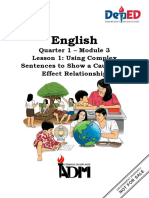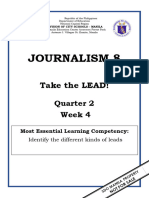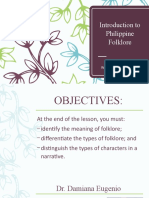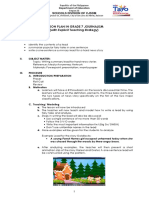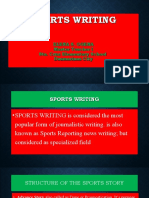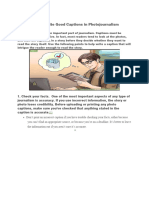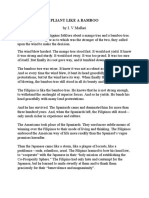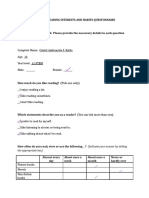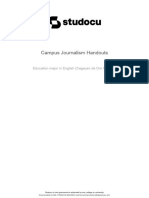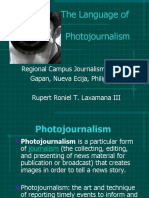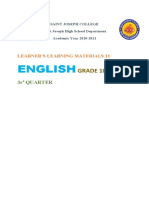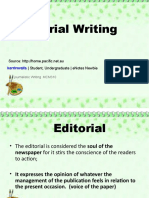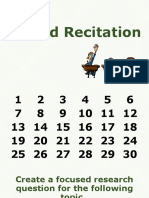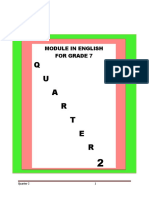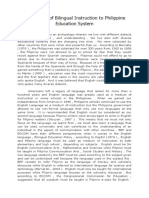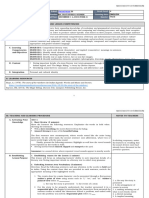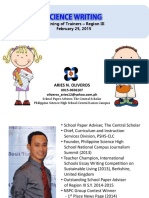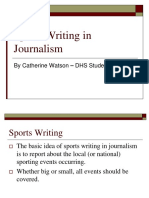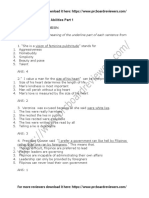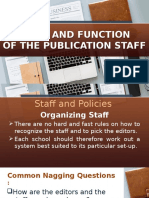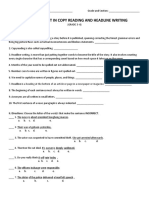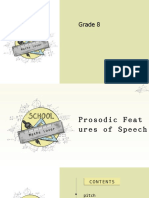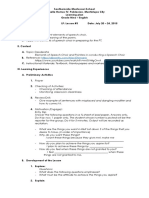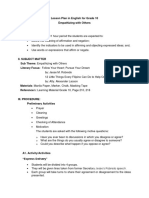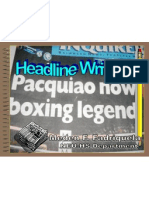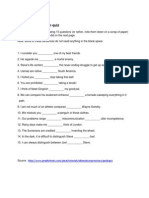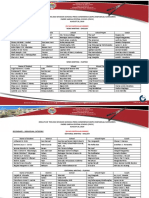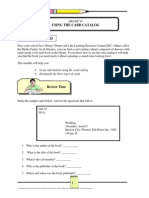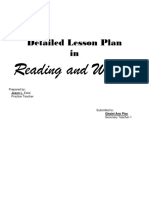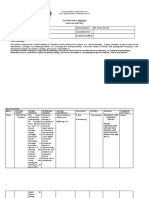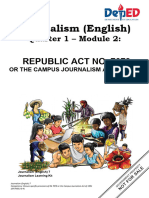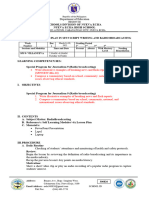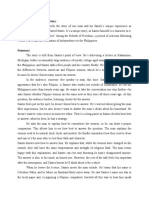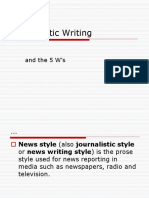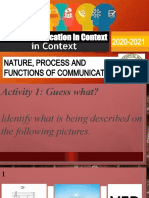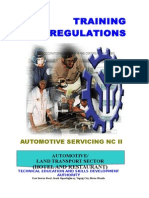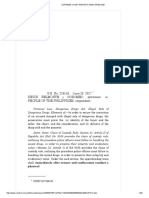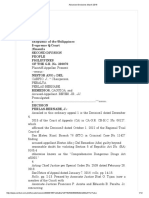0 ratings0% found this document useful (0 votes)
396 viewsJournalistic Writing
Journalistic Writing
Uploaded by
haizeJournalistic writing follows several key principles:
It uses concise language and avoids jargon. Stories answer the basic questions of who, what, when, where and why in the lead paragraph using an "inverted pyramid" structure. This puts the most essential information at the beginning so readers understand the essence even if they don't finish the article. The lead aims to attract readers with an attention-grabbing introduction to the topic.
Copyright:
© All Rights Reserved
Available Formats
Download as PPT, PDF, TXT or read online from Scribd
Journalistic Writing
Journalistic Writing
Uploaded by
haize0 ratings0% found this document useful (0 votes)
396 views9 pagesJournalistic writing follows several key principles:
It uses concise language and avoids jargon. Stories answer the basic questions of who, what, when, where and why in the lead paragraph using an "inverted pyramid" structure. This puts the most essential information at the beginning so readers understand the essence even if they don't finish the article. The lead aims to attract readers with an attention-grabbing introduction to the topic.
Original Title
Journalistic Writing.ppt
Copyright
© © All Rights Reserved
Available Formats
PPT, PDF, TXT or read online from Scribd
Share this document
Did you find this document useful?
Is this content inappropriate?
Journalistic writing follows several key principles:
It uses concise language and avoids jargon. Stories answer the basic questions of who, what, when, where and why in the lead paragraph using an "inverted pyramid" structure. This puts the most essential information at the beginning so readers understand the essence even if they don't finish the article. The lead aims to attract readers with an attention-grabbing introduction to the topic.
Copyright:
© All Rights Reserved
Available Formats
Download as PPT, PDF, TXT or read online from Scribd
Download as ppt, pdf, or txt
0 ratings0% found this document useful (0 votes)
396 views9 pagesJournalistic Writing
Journalistic Writing
Uploaded by
haizeJournalistic writing follows several key principles:
It uses concise language and avoids jargon. Stories answer the basic questions of who, what, when, where and why in the lead paragraph using an "inverted pyramid" structure. This puts the most essential information at the beginning so readers understand the essence even if they don't finish the article. The lead aims to attract readers with an attention-grabbing introduction to the topic.
Copyright:
© All Rights Reserved
Available Formats
Download as PPT, PDF, TXT or read online from Scribd
Download as ppt, pdf, or txt
You are on page 1of 9
Journalistic Writing
and the 5 W’s
…
News style (also journalistic style
or news writing style) is the prose
style used for news reporting in
media such as newspapers, radio and
television.
…
Journalistic prose is explicit and precise,
and tries not to rely on jargon. As a rule,
journalists will not use a long word when a
short one will do.
They offer anecdotes, examples and
metaphors, and they rarely depend on
generalizations or abstract ideas.
News writers try to avoid using the same
word more than once in a paragraph
(sometimes called an "echo" or "word
mirror").
…
The most important structural element of a
story is the lead — the story's first, or
leading, sentence.
Article leads are sometimes categorized
into hard leads and soft leads. A hard lead
aims to provide a comprehensive thesis
which tells the reader what the article will
cover. A soft lead introduces the topic in a
more creative, attention-seeking fashion.
__
Hard Lead: http://www.wsav.com/story/27883331/report-nfl-investigates-
deflated-footballs-in-afc-title-game
Soft Lead: http://www.nytimes.com/2015/01/20/upshot/how-forbidding-foie-
gras-increased-the-appetite-for-
it.html?hp&action=click&pgtype=Homepage&module=second-column-
region®ion=top-news&WT.nav=top-news&abt=0002&abg=0
…
News writing attempts to answer all the
basic questions about any particular event -
who, what, when, where and why (the
Five Ws) and also often how - at the
opening of the article.
This form of structure is sometimes called
the "inverted pyramid", to refer to the
decreasing importance of information in
subsequent paragraphs.
Inverted Pyramid
…
In the inverted pyramid, the essential and
most interesting elements of a story are
put at the beginning, with supporting
information following in order of
diminishing importance.
This structure enables readers to stop
reading at any point and still come away
with the essence of a story. It allows people
to explore a topic to only the depth that
their curiosity takes them.
…
Writers are often admonished "Don't
bury the lead!" to ensure that they
present the most important facts
first, rather than requiring the reader
to go through several paragraphs to
find them.
You might also like
- English5 - q1 - Mod3 - Lesson1 - Using Complex Sentences To Show Cause and Effect Relationship - FINAL07102020 PDFDocument27 pagesEnglish5 - q1 - Mod3 - Lesson1 - Using Complex Sentences To Show Cause and Effect Relationship - FINAL07102020 PDFhaize80% (5)
- JOURNALISM 8 - Q2 - Mod4 Kinds of LeadDocument16 pagesJOURNALISM 8 - Q2 - Mod4 Kinds of Leadkuramachakra13No ratings yet
- Lesson 2 Philippine Folklore ENG 7Document34 pagesLesson 2 Philippine Folklore ENG 7Monica Pendel Castro0% (1)
- Campus Journalism TrainingDocument19 pagesCampus Journalism TrainingLinda AgmataNo ratings yet
- Lesson Plan in Grade 7 Journalism (With Explicit Teaching Strategy)Document2 pagesLesson Plan in Grade 7 Journalism (With Explicit Teaching Strategy)John AmbasNo ratings yet
- Sports Writing - Earl 2Document17 pagesSports Writing - Earl 2Michael Edward De VillaNo ratings yet
- How To Write Good Captions in PhotojournalismDocument21 pagesHow To Write Good Captions in PhotojournalismTcher Lhing100% (1)
- Pliant Like A Bamboo: by I. V MallariDocument3 pagesPliant Like A Bamboo: by I. V MallariLyth LythNo ratings yet
- Estilo - Student Reading Interests and Habits QuestionnaireDocument4 pagesEstilo - Student Reading Interests and Habits QuestionnaireCristel Anthonette Estilo100% (2)
- St. Anthony College Calapan City, Inc.: Journalist's Code of Ethics (Philippines)Document22 pagesSt. Anthony College Calapan City, Inc.: Journalist's Code of Ethics (Philippines)xxxxNo ratings yet
- Diagnostic Test in Eng 7Document2 pagesDiagnostic Test in Eng 7LAIZA SOJONNo ratings yet
- Campus Journalism HandoutsDocument38 pagesCampus Journalism HandoutsAlimsog Integrated School (Region V - Albay)No ratings yet
- Adjective Order BunDocument13 pagesAdjective Order BunGetaNo ratings yet
- Summative Test in English 7Document30 pagesSummative Test in English 7Chou HanNo ratings yet
- Emulating Accomplished PeopleDocument11 pagesEmulating Accomplished PeopleCharissa Eniva Calinggangan86% (7)
- Las q3 Melc 1 FeatureDocument10 pagesLas q3 Melc 1 FeatureKathy TordillaNo ratings yet
- Photojournalism 1Document77 pagesPhotojournalism 1Angeli De GuzmanNo ratings yet
- Infomercial About BullyingDocument4 pagesInfomercial About BullyingJohn Michael FerrerNo ratings yet
- English 10 Module 11 LLMDocument6 pagesEnglish 10 Module 11 LLMrose ynqueNo ratings yet
- Editorial WritingDocument47 pagesEditorial Writingvillamor niez0% (1)
- DSPC GuidelinesDocument3 pagesDSPC GuidelinesNicole CasantusanNo ratings yet
- Various Types of News StructureDocument1 pageVarious Types of News Structureged rocamora50% (2)
- Activity Sheets7-8 (Using Appropriate Reading Style) W7-8Document7 pagesActivity Sheets7-8 (Using Appropriate Reading Style) W7-8Allan RemorozaNo ratings yet
- Feature WritingDocument40 pagesFeature WritingRomy Jr Delos SantosNo ratings yet
- Writing Summary LeadDocument34 pagesWriting Summary LeadMaria B. Cequena100% (2)
- Graded Recitation in EnglishDocument32 pagesGraded Recitation in Englisht3xxaNo ratings yet
- 2nd Quarter Module - Parts of A NewspaperDocument7 pages2nd Quarter Module - Parts of A NewspaperYanyan EducNo ratings yet
- First Quarter: Prosodic Features of SpeechDocument5 pagesFirst Quarter: Prosodic Features of SpeechAbi Ramirez Ramos-Sadang100% (1)
- Lesson 4 and 5 Salutation To The Dawn and Indonesian LiteratureDocument43 pagesLesson 4 and 5 Salutation To The Dawn and Indonesian LiteratureJoscelle Joyce RiveraNo ratings yet
- Cartooning & Photojournalism: DiscussionsDocument10 pagesCartooning & Photojournalism: DiscussionsMarinel VillezaNo ratings yet
- Criteria Essay WritingDocument2 pagesCriteria Essay WritingAira PangilinanNo ratings yet
- Synthesis PaperDocument2 pagesSynthesis PaperJulaton JericoNo ratings yet
- Seatwork Litotes and HyperboleDocument9 pagesSeatwork Litotes and HyperboleHeidee MatiasNo ratings yet
- Dll Matatag _english 4 q3 w1Document13 pagesDll Matatag _english 4 q3 w1Divine O. OcumenNo ratings yet
- Different News LeadsDocument4 pagesDifferent News LeadsIris DitanNo ratings yet
- ST WritingDocument28 pagesST WritingMarvie Caleon Delos SantosNo ratings yet
- Sports Writing in Journalism: by Catherine Watson - DHS StudentDocument14 pagesSports Writing in Journalism: by Catherine Watson - DHS StudentJhay B. MagtibayNo ratings yet
- CSE - Test On Verbal Abilities Part 1Document3 pagesCSE - Test On Verbal Abilities Part 1Vienna Corrine Quijano AbucejoNo ratings yet
- Campus JournalismDocument27 pagesCampus JournalismAlthea Mae Gelacio0% (1)
- Diagnostic Test in Copy Reading and Headline WritngDocument2 pagesDiagnostic Test in Copy Reading and Headline WritngPearl AsuncionNo ratings yet
- G8 Prosodic Features of SpeechDocument16 pagesG8 Prosodic Features of SpeechWella Faith Abayon100% (1)
- Speech Choir Lesson PlanDocument7 pagesSpeech Choir Lesson PlanJohn VicenteNo ratings yet
- Lesson Plan in English For Grade 10 Empathizing With OthersDocument7 pagesLesson Plan in English For Grade 10 Empathizing With Othersmica simanesNo ratings yet
- Headline Writing ChermedDocument66 pagesHeadline Writing ChermedMedem F. Fadriquela100% (2)
- Bias Prejudice QuizDocument22 pagesBias Prejudice QuizRuby JimenezNo ratings yet
- Idiomatic Expression QuizDocument15 pagesIdiomatic Expression QuizMiz MellNo ratings yet
- Results of 2019 DSPC Secondary in No Particular OrderDocument8 pagesResults of 2019 DSPC Secondary in No Particular OrderZaracruz CortezNo ratings yet
- Using Card Catalog To Locate InformationDocument13 pagesUsing Card Catalog To Locate Informationcrisanto_oroceo100% (2)
- Using The Card Catalog Grade6Document12 pagesUsing The Card Catalog Grade6Santa Dela Cruz Naluz100% (1)
- First, A Poem Must Be Magical FinalDocument13 pagesFirst, A Poem Must Be Magical FinalBernardita Gutib0% (1)
- LP. Comparison and ContrastDocument8 pagesLP. Comparison and Contrast어요당No ratings yet
- Feature WritingDocument25 pagesFeature Writingmarissa_ramos_87yahoNo ratings yet
- Curriculum Map in ENGLISH 8: School Year 2020-2021Document6 pagesCurriculum Map in ENGLISH 8: School Year 2020-2021Fe JanduganNo ratings yet
- Answer Key Grade 7Document13 pagesAnswer Key Grade 7Meynard Garcia CastroNo ratings yet
- SPJ G7W1C2Document17 pagesSPJ G7W1C2Guiann Hope NecorNo ratings yet
- SPJ 9 DLL Template F2FDocument3 pagesSPJ 9 DLL Template F2Fkrisciel26No ratings yet
- Scent of Apples SummaryDocument2 pagesScent of Apples SummaryAldine bartolazoNo ratings yet
- Feb 10 LP Singapore SojournDocument2 pagesFeb 10 LP Singapore SojournAida AguilarNo ratings yet
- English 10 - 3rd Performance TaskDocument2 pagesEnglish 10 - 3rd Performance TaskDaa Karen Mae CocaNo ratings yet
- Journalistic WritingDocument9 pagesJournalistic Writinghaize100% (1)
- Journalistic Writing: and The 5 W'sDocument9 pagesJournalistic Writing: and The 5 W'shaizeNo ratings yet
- Oral Communication in Context 2020-2021: Title Lorem IpsumDocument39 pagesOral Communication in Context 2020-2021: Title Lorem IpsumhaizeNo ratings yet
- TR - Auto Servicing NC IIDocument109 pagesTR - Auto Servicing NC IIJefferson GomezNo ratings yet
- Journalistic WritingDocument9 pagesJournalistic Writinghaize100% (1)
- Journalistic Writing: and The 5 W'sDocument9 pagesJournalistic Writing: and The 5 W'shaizeNo ratings yet
- 2 - Belmonte vs. PeopleDocument20 pages2 - Belmonte vs. PeoplehaizeNo ratings yet
- 3republic of Tbe !lbilippines $ Upreme Q:Court !fmanila Second Division People Philippines OF THE G.R. No. 230070Document12 pages3republic of Tbe !lbilippines $ Upreme Q:Court !fmanila Second Division People Philippines OF THE G.R. No. 230070haizeNo ratings yet
